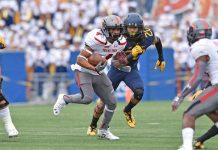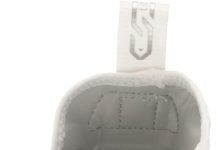Football fans have always been fascinated by the gripping performance of players, where every step counts, and every move can make or break a game. The question that often comes up is, “Does the NFL still use metal cleats?” After all, metal spikes on the sole of a football player’s shoe have historically provided unparalleled traction on the field. In this article, we explore whether this traditional footwear choice is still prevalent in the modern era of the NFL.
History of NFL Football Cleats
Review contents
Early days of NFL cleats
In the early days of NFL football, cleats were not as advanced as they are today. During the early 1900s, players utilized basic cleats with leather uppers and metal studs on the sole. These metal cleats provided a strong grip on the slippery turf, allowing players to maneuver swiftly and change direction quickly. However, they also posed a risk of causing significant injuries to both the wearer and opponents due to their sharp edges and potential to penetrate the skin.
Evolution of cleats in the NFL
Over the years, the design and technology of NFL cleats have significantly evolved. With advances in materials, safety regulations, and player preferences, cleats have become more specialized and tailored to the needs of professional football players. From the early metal cleats, the industry witnessed a shift towards the use of molded rubber or plastic cleats. These new cleats offered improved grip, better comfort, and reduced injury risk. The NFL’s constant drive for player safety and performance optimization led to the development of new cleat regulations and advancements in cleat technology.
Advantages and Disadvantages of Metal Cleats
Advantages of metal cleats
Metal cleats provide several advantages that have made them popular among some NFL players. One of the key advantages is their superior traction on various playing surfaces. This increased grip can be crucial for players who compete on wet or muddy fields, enabling them to maintain stability and make explosive movements. Additionally, metal cleats are highly durable and long-lasting, making them a cost-effective choice for players who prefer a more rugged and traditional feel.
Disadvantages of metal cleats
Despite their benefits, metal cleats also have certain disadvantages. One major concern is the potential for serious injuries. The sharp metal studs can cause deep cuts and punctures, not only to the player wearing them but also to opponents during tackles or collisions. Another drawback is their limited versatility. Metal cleats perform exceptionally well on natural grass surfaces, but they can be problematic on artificial turf, which may require different types of cleats. Lastly, metal cleats tend to be heavier compared to their molded counterparts, which can affect a player’s speed and agility.
Current NFL Cleat Regulations
Material regulations for NFL cleats
The NFL has implemented specific regulations regarding the materials used in the construction of football cleats to ensure player safety and fair competition. The league strictly prohibits the use of certain materials, such as glass or other sharp objects, which could cause harm to players. Additionally, the NFL mandates that all cleats meet certain durability standards to withstand the demanding playing conditions. These regulations ensure a level playing field and protect players from potential injuries caused by faulty or unsafe cleat materials.
Specifics about metal cleat usage
While the NFL does not explicitly ban the use of metal cleats, the league enforces certain restrictions to minimize the risks associated with their use. Players are allowed to wear metal cleats, but they must ensure that the metal studs do not extend beyond a certain length, usually three-quarters of an inch. This limitation aims to reduce the severity of potential injuries caused by excessive or excessively sharp metal studs. Moreover, NFL officials closely inspect players’ cleats before each game to ensure compliance with the rules and maintain a safe playing environment.
Metal Cleats vs. Molded Cleats
Differences in construction
The construction of metal cleats and molded cleats differs significantly, affecting their performance and suitability for different playing conditions. Metal cleats typically feature a leather upper for durability and comfort, coupled with a sole containing strategically placed metal studs to provide maximum traction. In contrast, molded cleats are made of synthetic materials, such as rubber or plastic, with the studs incorporated into the sole during manufacturing. These molded studs are often shorter and wider, providing ample grip on various surfaces without the risk of puncture or injury.
Performance comparison
The choice between metal cleats and molded cleats largely relies on personal preference and playing conditions. Metal cleats excel on natural grass fields, particularly in wet or muddy conditions, where they offer superior traction. They allow players to dig into the ground and change direction explosively. On the other hand, molded cleats are more versatile, performing well on both natural grass and artificial turf. They provide reliable traction without the same level of injury risk associated with metal cleats. The decision on which type of cleat to use ultimately depends on a player’s specific needs, playing style, and the prevailing field conditions.
Safety Concerns
Injuries related to cleats
Though advancements in cleat technology have improved player safety, the use of metal cleats still presents certain risks. Due to the sharp and potentially protruding metal studs, players can suffer severe lacerations, puncture wounds, or other types of skin injuries. These injuries not only impact the immediate well-being of the players involved but can also have long-term consequences and impact their careers. Additionally, the risk extends beyond the wearer to opponents, as metal cleats can cause injury during tackles or accidental contact.
Safety measures taken
In response to the safety concerns associated with metal cleats, the NFL and other governing bodies have implemented various safety measures. Stringent material regulations and inspection protocols ensure that cleats meet specific safety standards before being permitted on the field. Additionally, advancements in manufacturing techniques have led to the development of cleats with improved safety features. Some manufacturers have introduced protective coverings or guards over the metal studs, reducing the likelihood of injury. These safety measures demonstrate the commitment of the NFL and industry stakeholders to prioritize player well-being without completely banning the use of metal cleats.
Player Preferences
Players’ choice between metal and molded cleats
The choice between metal and molded cleats is largely determined by individual player preferences and playing style. Some players prefer the traditional feel and increased traction provided by metal cleats. They appreciate the ability to dig into the ground, especially in inclement weather conditions, to gain an advantage over their opponents. Conversely, other players prioritize safety and versatility, opting for molded cleats that offer comparable traction with reduced injury risks. Ultimately, the decision often comes down to personal comfort and confidence in performance.
Factors influencing player preferences
Several factors contribute to players’ preferences when choosing between metal and molded cleats. Field conditions play a significant role, with players favoring metal cleats for natural grass surfaces, particularly in wet or muddy weather. Position-specific requirements can also influence a player’s choice, as different positions demand varying levels of agility, speed, and cutting ability. Additionally, previous injuries may impact a player’s decision, with those who have experienced cleat-related injuries more likely to opt for safer alternatives. Finally, individual player superstitions or rituals may also come into play, with some athletes sticking to what has worked for them in the past.
Use of Metal Cleats in Other Leagues
Comparison with college football regulations
The regulations surrounding the use of metal cleats in college football differ from those in the NFL. While the NFL imposes restrictions on the length and sharpness of metal studs, college football allows players to wear metal cleats without such limitations. This distinction reflects the varying levels of oversight and safety considerations across different leagues. However, even in college football, certain conferences or individual teams may choose to enforce stricter rules on the use of metal cleats to prioritize player safety.
Metal cleats in high school football
In high school football, the rules regarding the use of metal cleats vary from state to state and even within different districts. Some states prohibit the use of metal cleats altogether, favoring molded cleats for safety reasons, or mandate specific guidelines for their use. The regulations aim to strike a balance between allowing players to utilize equipment they feel comfortable with, while also minimizing the potential risks posed by metal cleats. The importance of player safety is a common consideration across all levels of football, leading to varying levels of restrictions on the use of metal cleats.
Famous NFL Players Known for Metal Cleats
Notable players who used metal cleats
Over the years, numerous NFL players have sported metal cleats, leaving a lasting impact on the game. One such player is Hall of Fame wide receiver Jerry Rice, who was notorious for wearing metal cleats throughout his illustrious career. Rice’s use of metal cleats is often credited for his incredible ability to make sharp cuts and maintain balance, contributing to his unparalleled success on the field. Another prominent player associated with metal cleats is Hall of Fame running back Barry Sanders, who relied on their superior traction and stability to evade defenders and make electrifying plays.
Impact on their performance
The use of metal cleats by players like Jerry Rice and Barry Sanders undoubtedly influenced their performance on the field. The heightened traction and stability provided by metal cleats allowed them to burst off the line of scrimmage, make quick cuts, and maintain balance while running at high speeds. By utilizing metal cleats effectively, these players were able to take their agility and explosiveness to the next level, leaving defenders in their wake. Their success with metal cleats contributed to the ongoing debate surrounding the advantages and potential risks associated with their use.
Future Trends in NFL Cleat Technology
Advancements in cleat materials
As technology continues to advance, the materials used in NFL cleats are expected to evolve as well. Manufacturers are constantly exploring new materials and innovative designs to enhance performance, durability, and player safety. The future may see the development of new lightweight materials that offer excellent traction while reducing the risk of injury. Additionally, advancements in shock absorption technology could be incorporated into cleats to minimize the impact on players’ joints, providing added protection and comfort.
Possibilities for future cleat designs
In addition to material advancements, future cleat designs may also focus on customization and personalized fit. With advances in 3D printing and scanning technologies, manufacturers could offer bespoke cleats tailored to the unique foot shape and playing style of individual players. A more precise fit could lead to improved performance, reduced risk of injuries, and enhanced overall comfort. Additionally, increasing emphasis on sustainable and eco-friendly practices may drive innovations in cleat manufacturing that promote environmentally conscious materials and production processes.
Final Verdict
Current use of metal cleats in the NFL
While metal cleats are not as prevalent in the NFL as they once were, some players still opt to use them. The current NFL regulations allow for the use of metal cleats within certain parameters, aiming to balance player performance with safety considerations. It is important to note, however, that the usage of metal cleats varies among players, with many choosing the alternative molded cleats for their safety and versatility advantages.
Predictions for the future
Looking ahead, it is likely that the use of metal cleats in the NFL will continue to decrease as players prioritize safety and opt for modern cleat technologies. The league’s commitment to player welfare and the ongoing advancements in materials and manufacturing techniques will likely lead to the development of even safer and more effective cleats. While metal cleats may continue to have a nostalgic appeal and be favored by a select few, the trend suggests a gradual shift towards molded cleats that offer comparable performance benefits without the same injury risk. As the NFL evolves, so too will the technology behind football cleats, ensuring that players have the best footwear to excel on the field while maintaining their safety.





































